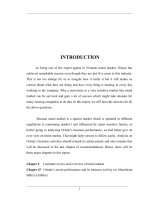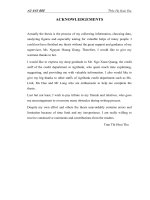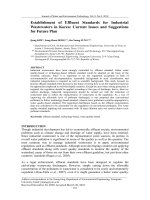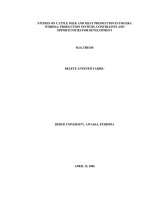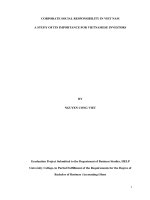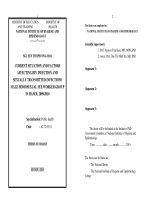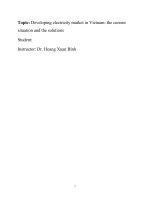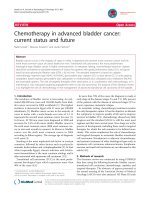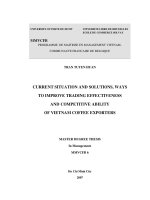Corporate culture in FIFTH MEDIA GROUP current situation and recommendations for vietnamese enterprises
Bạn đang xem bản rút gọn của tài liệu. Xem và tải ngay bản đầy đủ của tài liệu tại đây (1.84 MB, 95 trang )
ii
Academy of Finance
Graduation thesis
ACKNOWLEDGEMENT
This thesis includes a lot of details and varieties, thus it would be difficult carry out it
on one’s own. This study receives encouragement and help from many people and I
feel indebted to their ads, and wish to express my gratitude to them.
First and foremost, I would like to convey my special thanks to my supervisor, Ms Bui
Thi Bich Thuy for her guidance, suggestions and invaluable advice in the knowledge as
well as in English editing. Without her, this thesis could not have been completed.
Special thanks to all instructors without whose knowledge and assistance this thesis
would not have been successful. My debt is also acknowledged to Fifth Media Limited
Company for allowing me to do the internship in Fifth Media Group office and Ms
Nguyen Thu Dung – my direct supervisor in Thanh Xuan transaction office. I truly
appreciate all thes enthusiastic contributions.
And finally, I am extremely grateful to all staff of Fifth Media Group who cooperated
with me during the survey and helped me with all the valuable information for my
study.
iii
Academy of Finance
Graduation thesis
LIST OF FIGURES AND TABLES
Figure 1.1: Role culture……………………………………...……………………………….12
Figure 1.2: Task cultur…………...……………………………...……………………………13
Figure 1.3: Power culture………………………………………...…………………...............13
Figure 1.4: Person culture…………………………………………...………………………..14
Figure 1.5: Organizational culture model of Fons Trompenaars and Charles HampdenTuner…………………………………………………………………………………………..15
Figure 1.6: Elements of corporate culture…………………………………………………….16
Figure 1.7: Denison model of organizational culture……………………...…………………18
Figure 2.1: Developing history of Fifth Media Group………………………………………..24
Figure 2.2: Organizational structure of Fifth Media Group…..................................................26
Figure 2.3: Slogan and logo of Fifth Media Group…………………………………………..29
Figuer 2.4 – 2.5: Settings in Fifth Media Group working rooms……………………………..31
Figure 2.6-2.7-2.8: Ceremonies in Fifth Media Group……………………...…………….32,33
Figure 2.9-2.10: Cozy lunch with Board of Directors at Fifth Media Group..………………34
Figure 2.11-2.12: Training time at Fifth Media Group………………………..……………..35
Figure 2.13: Dressing code in Fifth Media Group……………………………..…………….36
Figure 2.14: Gender distribution of the sample…………………………………..…………..41
Figure 2.15: Tenure in years………………………………………………………...………..42
Figure 2.16: Department distribution of the sample…………………………………...……..42
Table 2.1: Descriptive statistics for Organizational Culture Survey………………………….43
Table 2.2: Abbreviations using in Organizational Culture Correlation Matrix…………....…45
Table 2.3: Correlations of the dimensions of the Organizational Culture……………...…45,46
Figure2.17: Corporate culture of Fifth Media Group……………………………………..….51
iv
Academy of Finance
Graduation thesis
TABLE OF CONTENTS
Declaration……………………………………………………………...………………i
Acknowledgement……………………………………………………….…………….ii
List of figures and tables…………………………………………………….……….iii
Table of contents……………………………………………………….......................iv
Introduction
1.
Rationale of study
2.
Aims of study
3.
Scope of study
4.
Methods of study
5.
Structure of study
CHAPTERS
1.
CHAPTER I: LITERATURE REVIEW
1.1
Definition of Corporate Culture
1.1.1
Definition of Culture
1.1.2
Definition of Corporate Culture
v
Academy of Finance
Graduation thesis
1.2
Impacts of corporate culture
1.2.1
Corporate culture can create internal reinforcement for organisations.
1.2.2
Corporate culture can be a tool of management control.
1.2.3
Corporate culture can be a powerful tool to enhance competitive
advantage.
1.2.4
Negative corporate culture can be a factor to resist movement and
innovation.
1.3
Factors affecting corporate culture
1.3.1
National culture
1.3.2
Role of leadership
1.3.3
Learned cultured values
1.4
Types of corporate culture
1.4.1
Role culture
1.4.2
Task culture
1.4.3
Power culture
1.4.4
Person culture
1.5
Corporate culture models
1.5.1
The model of Edgar H. Schein
1.5.1.1 Artifacts
1.5.1.2 Espoused values
1.5.1.3 Basic underlying assumptions
1.5.2
The model of Daniel R.Denison
vi
Academy of Finance
Graduation thesis
1.5.2.1 Mission
1.5.2.2 Consistency
1.5.2.3 Involvement
1.5.2.4 Adaptability
2.
CHAPTER II: CURRENT CULTURE SITUATION OF FIFTH MEDIA
GROUP
2.1
Introduction to Fifth Media group
2.1.1
History of Fifth Media Group
2.1.2
Organizational structure
2.1.3
Business activities
2.2
Analyzing Fifth Media group’s corporate culture
2.2.1
Performance of Fifth Media Group’s corporate culture acording to Edgar
H.Schein model
2.2.1.1 Artifacts
2.2.1.2 Espoused values
2.2.1.3 Basic underlying assumptions
2.2.2
Performance of Fifth Media Group’s corporate culture according to
Daniel R. Denison
2.2.2.1 Descriptive statistics of the Denision Organizational Culture Survey
2.2.2.2 Inferential statistics of the Denison Organizational Culture Survey
2.2.2.3 Four dimensions of Fifth Media Group’s corporate culture based on
Denison model
vii
Academy of Finance
2.3
Evaluating Fifth Media group’s corporate culture
2.3.1
Fifth Media Group’s corporate culture strengths
Graduation thesis
2.3.1.1 Base on Shein model
2.3.1.2 Base on Denison model
2.3.2
Fifth Media Group’s corporate weakness.
3.
CHAPTER III: CONCLUSION AND RECOMMENDATIONS FOR
VIETNAMESE ENTERPRISES
3.1
Conclusions
3.2
Limitations and avenue for future research
3.3
Recommendations for Fifth Media Group and Vietnamese enterprises to
improve the corporate culture
3.3.1
Recommendations for FIFTH MEDIA GROUP to improve the corporate
culture
3.3.1.1 Improve the core values system
3.3.1.2 Increase the empowerment among the whole group
3.3.1.3 Develop the ability to adapt to change
3.3.1.4 Spread out the strategic direction and intent
3.3.1.5 Focus on improving intangible cultural values
3.3.2
Overview of corporate culture in Vietnam at present
3.3.3
Recommendations for Vietnamese enterprises to build up and maintain a
corporate culture
3.3.3.1 Improve the awareness of corporate culture
viii
Academy of Finance
Graduation thesis
3.3.3.2 Leader of the enterprise should be a typical visible role model
3.3.3.3 Harmonize between individuals’ strengths and corporation’s
requirements
3.3.3.4 Strengthen material investment in building and developing organisational
culture
3.3.3.5 Widely disperse the sense of mission in the whole organization
3.3.3.6 Increase the adaptability of the organization
3.3.3.7 Improve the involvement of employees
3.3.3.8 Reinforce the consistency of the organization
REFERENCES
APPENDIX
1
Academy of Finance
Graduation thesis
1
Academy of Finance
thesis
Graduation
INTRODUCTION
1.
Rationale of study
How could corporations create the differences from the others to be successful in a
modern world context as today? What is the strategy that a firm should implement
to survive and prosper in the highly competitive environment where concepts such
as “integration” or “globalization” are not something new to people’s mindset?
Gradually, explanation and solution to find answers for such those questions are on
the top priority of each strategy formulated by leaders of worldwide companies, and
Vietnamese ones particularly. Apparently, developing business activity and a strong
enterprise community are the key factors to help the development of each country
should be soon well-emerged. However, how to build up a globally competitive
community and maintain the personality of each country still needs much
consideration of strategic planners. This leads to the idea of building up a corporate
culture to represent the unique identity in the process of global integration.
However, acknowledgement and an accurate point of view of the corporate culture
and the importance it brings to the success and outstandingly positions organization
on the market are not widely received, especially to Vietnamese market where the
limitation of economic development and education are still in existent. Hence, in
order to enhance the position of Vietnam in the world arena, it is essential that
corporate culture building and maintaining issues should be given significant
consideration by all Vietnamese leaders.
With those critical factors above, the author proposes to make a clear and deep
analysis on how corporate culture places a considerable effect on the success of a
Vietnamese enterprise, on the basis of assessing the current situation at FIFTH
MEDIA GROUP, a leading company in the mobile and digital marketing service in
Vietnam. After that, on that basis, the author focuses thoroughly on how to reinforce
those cultural strengths through suggesting some recommendations, which can draw
many valuable lessons for Vietnamese enterprises to follow.
2
Academy of Finance
thesis
Graduation
For those above reasonable implications, the author decides to make deep analysis
in the topic of “Corporate culture in FIFTH MEDIA GROUP: current situation
and recommendations for Vietnamese enterprises”.
2.
Aims of study
How farther researches may imply, standing on a FIFTH MEDIA GROUP shoulders
is also the aim this thesis trying to achieve. The research is fueled by two main
objectives, namely:
a. To find out the elements, the relationship, and contributions of employees to
the corporate culture of FIFTH MEDIA GROUP.
b. To evaluate those factors in helping FIFTH MEDIA GROUP build up and
maintain a corporate culture.
On the basis of two main objectives, to suggest, and learn valuable lessons from
FIFTH MEDIA GROUP’s corporate culture, which could be a typical example for
other enterprises to study. Hence, the underlying thread of those objectives is the
urge to improve self – knowledge of how corporate culture could affect the
effectiveness of an organization in the market, to raise strong awareness of the
importance of corporate culture among Vietnamese enterprises and finally to
provide Vietnamese enterprises with a noteworthy case study and valuable lessons
from the corporate culture of FIFTH MEDIA GROUP.
The thesis revolves around five main questions:
i.
What is corporate culture, its elements, its impacts and models to assess the
corporate culture of an organization?
ii. Which elements that FIFTH MEDIA GROUP’s corporate culture consist of?
iii. Which model to base on to assess and evaluate the corporate culture of FIFTH
MEDIA GROUP?
iv.
What lessons could be learned from FIFTH MEDIA GROUP’s corporate
culture to for Vietnamese enterprises to build up a corporate culture?
3. Scope of study
3
Academy of Finance
thesis
Graduation
The study concentrates on analyzing and evaluating the corporate culture, an
important factor contributing to the success and development of the organization by
making a deep analysis on what corporate culture actually is, which components it
consists of and model on which research could base on.
Especially, the research is conducted at FIFTH MEDIA GROUP by making
use of knowledge in the field of corporate culture in both qualitative and
quantitative perspectives. However, limited time and length allowed for this thesis
do not rationalize such an extension of time, only focusing on the current situation
of corporate culture building of this group as well as referring to some documents
ranging from period from 2007 up to now.
Although the thesis seeks to analyze and evaluate corporate culture of a
specific firm in a particular industry, i.e. FIFTH MEDIA GROUP in the mobile &
digital marketing service, the range of its practical application covers any firm who
find the approaches fit their way when struggling for building its own corporate
culture to survive and succeed in the face of stiff global competition. The broader
time frame has been traded off by the density of focus. However, recommendations
are elaborated only for Vietnamese enterprises in particular, taking on account
internal and external influencing factors pertaining to them.
4. Methods of study
In terms of methodology, different from other previous research, methodological
analysis of mixed- methods approach would be applied. Importantly, the research
design includes questionnaires using Denison Organizational Culture Survey,
interviews, observations and the procedures to conduct these techniques are also
described.
5.
Structure of study
The framework structuring this research is composed of three main chapters.
The first chapter is Literature review, providing the theoretical framework of
corporate culture for the whole thesis. And last but not least, conclusions and
Recommendations as the fifth chapter carries a succinct summary of the research
4
Academy of Finance
thesis
Graduation
findings and valuable recommendations to be retained in the leaders’ mind for a
long time.
5
Academy of Finance
thesis
Graduation
CHAPTER 1: LITERATURE REVIEW
This section looks at different aspects of corporate culture including concept of
culture in general, definitions of corporate culture, its importance and components.
A brief review of some models used by other researchers to assess corporate culture
is also included. Following their use in extant research, the two terms
“organizational culture” and “ corporate culture” are used interchangeably in the
present research.
1.1
Definition of corporate culture
1.1.1 Definition of culture
Empirical researches by various authors have revealed many definitions of culture.
Especially, since the early 1952, in their famous work named as “A Critical Review
of Concepts and Definitions”, two American anthropologists A.L.Kreber and
K.Klaxon introduced 164 different difinitions of cultures and up to now, the number
of definitions on culture has grown to nearly 400. However, in this study, some of
definitions which are commonly accepted and so popular should be reviewed to best
understand and define the term “culture” on a general basis.
In 2002, UNESCO launched the definition of culture as follows:
“Culture should be mentioned as a specific set of spiritual, physical, and emotional
knowledge of a society or group of people and mode of living together, value
systems, traditions and beliefs”.
Another widely accepted definition of culture is one given by the American
anthropologist Edward. B. Tylor (1889), in which culture is defined as “that
complex whole which includes knowledge, belief, art, morals, law, customs, and
any other capabilities and habits acquired by man as a member of society.”
Damen. L. (1987), in the article “Culture Learning: the Fifth Dimension on the
language Classroom” defined culture as “learned and shared human patterns or
models for living, day-to-day living patterns. These patterns and models pervade all
6
Academy of Finance
thesis
Graduation
aspects of human social interaction. Culture is markind’s primary adaptive
mechanism.
Another definition of culture given by Hofstede. G. (1984) in the book “National
cultures and corporate cultures” as follows: “Culture is the collective programming
of the mind which distinguishes the members of one category of people from
another.”
In general, culture could be understood as the shared patterns of behaviors and
interactions, cognitive constructs, and the affective understanding which are learned
through a process of socialization. These patterns could identify the members of a
culture group while also distinguish those of another group.
1.1.2 Definition of corporate culture
The concept and studying of “corporate culture” or “organizational culture” have
been carried out and become popular since the early 1980s. Accompanying with the
growing concern on the topic, there seems to be little agreement within the literature
as to what “corporate culture” actually is and, therefore, there are different
definitions and perspectives on this topic.
Gareth Morgan (1997) described corporate culture as: “The set of beliefs, values,
and norms, together with symbols like dramatized events and personalities that
represents the unique character of an organization, and provides the context for
action in it and by it.”
Whereas Hofstede(1984) wrote of “the collective programming of the mind which
distinguishes the members of one human group from another” as the explanation of
the term organizational culture, which reveals an interesting way of understanding
the notion, and then he “discovered” four areas of work related value differences at
that time, including “power distance, uncertainty avoidance, individualism /
collective, masculinity / femininity”.
Edgar Schein (1985), one of the most famous and most respected theorists dealing
with corporate culture said that the definition of corporate culture should be general;
otherwise some factors which are actually part of corporate culture will be
7
Academy of Finance
thesis
Graduation
eliminated. Schein’s definition of corporate culture, specified in his book
“organizational culture and leadership” is: “A pattern of shared basic assumptions
that the group learned as it solved its problems that has worked well enough to be
considered valid and is passed on to new members as the correct way to perceive,
think, and feel in the relation to those problems. “Although the ideas are expressed
in a different way, the two definitions are nearly the same in essence.
In his book “Organizational Culture”, Andrew Brown (1995, 1998) stated the
definition of organizational as “Organizational culture refers to the pattern of
beliefs, values and learned ways of coping with experience that have developed
during the course of an organization’s history, and which tend to be manifested in its
material arrangements and in the behaviors of its members.”
Meanwhile there are many definitions, explanations and perspective on corporate
culture, all of them converge on the same points the shared nature of the collective
experience, routine, beliefs, values, goals, and system. In essence, many claimed
that the function of corporate culture is to create a feeling of the spirit of the
organization. These are learned and re-learned, passed on to new employees, and
continues on as part of a company’s core identify. If this is so, then we should
attempt to examing why corporate culture is regarded so important and valuable.
1.2
Impacts of corporate culture
Corporate culture has played a very important role in managing a corporation and
driving it to success. As a result, it has gained a significant attention by managers
and company’s strategic planners so that its importance could be applied and
performed appropriately.
1.2.1 Corporate culture is a powerful tool to create competitive advantage
Corporate culture is considered as a powerful tool for improving business
performance (Brown, 1995), and reinforcing the competitive advantage against the
organization’s competitions. In other words, corporate culture creates unique
features for organizations. Retrieved from many researches and studies dedicated to
understand the effects of corporate culture on organizations, it can be seen that there
8
Academy of Finance
thesis
Graduation
are positive correlations associated with building and continuously managing
culture. It cannot be denied that, building a strong corporate culture is an important
asset because it differentiates an organization from competitors. Positive corporate
culture has become more important when studies reveal the benefits of increasing
overall business performance; excellent corporate culture has some characters
belonging to the source of sustainable competitive advantage. For example, some
companies like Hewlett-Packard and IBM, the corporate culture within the two
companies has become a competitive advantage over their competitors.
1.2.2
Corporate culture can be a tool of management control
Corporate culture can additionally be a tool of manangement control. Because
corporate culture influences all the activities within an organization, managers could
use selected values, rites, stories, symbols and common values to control and direct
employee’s behavior. From the future point of view, this form of control could be
less expensive and more effective and could enhance commitment of members to
the organization and its goals. Hence, it an be inferred that management today is
“moving from bureaucratic control to humanistic control”. In the current society,
both companies and organizations are seeking the way to satisfy their members’
needs physically and emotionally by furnishing them with satisfying work,
appropriate tasks or a desirable team working life through internal control, and all
those aims could be achieved with the help of their organizational culture, and only
with a complete and pleasant understanding of organizational culture, individuals
would be more willing to commit themselves to their organizations.
1.2.3 Corporate culture can create internal reinforcement for organizations.
Corporate culture could be a good and substantial factor to attract and maintain
skilled workforce to the organization. Studies has revealed that employees are
working for a company not only due to a high salary, but also a satisfactory working
environment and opportunities to get promotion offered by that company. The
corporation fulfills employees’ requirement of self-interest through improvement in
the material culture construction, especially the institution of “performance of
evaluation” and “payment for labor”. Then, the corporation will have the incentive
9
Academy of Finance
thesis
Graduation
functions related to employees’ job motivation. These factors
confirm the
importance of appropriately controlled human resource managerial policies, and
work delegation. So it can be said that, excellent corporate culture can supply the
gap of bounded ration and make all employees’ behaviors in accordance with the
direction and common target of the corporation.
1.2.4
Negative corporate culture can be a factor to resist change and
innovation
Although corporate culture can be a good engine and objective for the development
of an organization, a negative one can be a factor to resist change and innovation.
Reality in almost worldwide successful companies could be a noteworthy proof for
a good set of values and assumptions. Meanwhile, companies at lower level either
belong to two groups, one don’t have a widely expressed corporate core values
system, or one have only financial objective system. To some extent, those
companies have a negative corporate culture may possess a rigid authority system,
i.e. on the contractual basis, which seems to be stiff, authorized, and bureaucratic.
This kind of organization often has a negative environment, staffs are indifferent or
resist to leaders. In other words, there is no connection between them apart from
working relationship. It is well understood the reason why such companies cannot
move further or exist sustainably.
1.3 Factors affecting corporate culture
1.3.1 National culture
In the development process of an organization, national culture always has an
impact (direct or indirect) on many different aspects on the culture of the
corporation. That is the reasons explains why the different between Western and
Eastern corporate culture, the corporate culture of Islam nation and corporate
culture of those countries by Christians or Buddhists could be realized obviously.
Especially in a multinational corporation, each employee comes from a different
culture, so that the corporate culture could be influenced as the convergence of
those cultures, creating a diversity and variety in the culture of the company.
10
Academy of Finance
thesis
Graduation
National culture influences on the formation and development of an organization by
creating characteristics, expressing the features such as leadership style, the degree
of power decentralization in the enterprise, equality, etc.
1.3.2 Role of leadership
By far, it can be said that the most important element and basis for cultural
beginning is the impact of leaders and founders. They not only choose the basic
mission as well as the environmental context where the new group will perform, but
they choose the members of the group and bias the orginal responses that the group
makes in its efforts to succeed in its environment and to integrate itself. In an
organization, leaders are people who are responsible for formulating and
implementing the strategy – they are the ones deciding what they are going to do
and then actually figuring out how they are going to do”. The main founders and
leaders’ success, along with their behaviors help the organization create the own and
unique culture. Additionally, the characters or the main founders with visionary
capabilities associated with their aspirations have identified a set of vision and
mission for the whole group. The formation of organizational culture of a certain
group is based on and identified by the leadership styles. Hence, leadership is
originally the origin of the beliefs and values that direct a group moving forward
and dealing with its both internal and external problems. In general, corporate
culture is based on the tone and style of leadership. Each style, each decision and
each person could affect the culture within an organization.
1.3.3 Learned cultural values
Collective experiences of the organization are learned from practice when dealing
with common problems which are widely expressed throughout the company, and
introduced to new staffs, such as experiencing in dealing and serving clients,
reacting to changes, working in team, etc. Moreover, cultural values are learned
from other companies in the industry, which could be the result of the conducting
the market researches, competitors study, competition and exchange programs
among companies. This progress begins when some staffs learn such values from
other companies, then spread and transfer to the other colleagues, and become the
11
Academy of Finance
thesis
Graduation
common values of the organization. Especially in case of multinational
corporations, organizations’ sending their employees abroad to attend training
courses, or having foreign partners, cultural values could be established through the
convergence various cultures brought back by their staffs. Cultural values could be
acknowledged after a long time of adaptation, and then become the common values
of the whole group. Corporate culture of an organization could be also influenced
by the common and latest social trend.
In short, it is not an easy task to generalized all forms of learned cultural values,
however, these values are acknowledged and shared widely within the whole
company. It is essential for leaders to receive and take advantage of those values to
build up a strong own corporate culture, to create a cultural environment and
achieve the management goals, as well as support the business performance of the
company.
1.4
Types of corporate culture
Balthazard and Cooke (2004) demonstrated that organizational cultures types have
been associated certainly with either positive or negative results for both the
effective performance of the organization and for individual achievement of
employees within the organization. Some other researchers have administered some
basic types of organizational cultures, such as Charles Handy (1991), Kim Cameron
and Robert Quinn (1998), Davidson (2004), etc. However, in this research, the
author focuses mainly on the study on the types of organizational culture of Chales
Handy (1991). In his research, he figured out a simple framework to categorize
cultures. Handy also mentioned four Greek Gods to make an illustration for his
basic approaches as well as the organizational cultures that result. His four
organizational cultures are very simple for people fo understand. Groups will find it
very easy to identify and explore their own corporate culture through the model he
uses: Role culture, Power culture, Task culture and Person culture.
1.4.1 Role culture
12
Academy of Finance
thesis
Graduation
Role culture has been symbolized as a Greek temple, the image which has often
been stereotyped as implying bureaucracy in the purest form. The top of the temple
is where the final decision making is made; whereas the pillars of the temple
portrait all functional units of the organization in which implementing the decisions
from the apex has to be made. The strength of the culture lies in specialization
within its pillars. Interaction takes place between the functional specialism,
influenced by job descriptions, procedures, rules and systems ( Leigh Zwaan, 2006).
An authority is not based on personal initiative but is dictated by job descriptions.
Figure 1.1: Role culuture
Source: Handy (1991), Gods of management
Pretorius (2004) demonstrated that this type of culture is identified and established
when task within and between departments is controlled by procedures, role
description, as well
as authority definitions, where mechanisms and rules are
necessary to process decisions and resolve conflicts.
1.4.2
Task culture
Struwig and Smith (2002) stated that task culture is identified when the culture is
based on job or project orientation and extremely adaptable. Especially, for a
particular problem, both people and resources can be mobilized from various parts
within the organization on the temporary basis. This type of culture is represented
best by a net or lattice work. This implies a close relation among departments,
different functions and specialities as well as liation, communication and integration
which are the means the organization can base on to anticipate and adapt to change
quickly.
13
Academy of Finance
thesis
Graduation
Figure 1.2: Task culture
Source: Handy (1991), Gods of manangement
Pretorius (2004) referred task culture as the project team culture where the main
emphasis is on the result and getting things done. As be concluded that, the main
idealof task culture is to take advantages of right people and best resources together
to utilize this power to achieve the business goals. (Leigh Zwaan, 2006).
1.4.3
Power culture
Struwing and Smith (2002) stated that power culture is type that depends on power
and is affected by a central figure. The organization is liable on the ability of
judgement of the central power. This type of culture could be best described as the
web, which is illustrated in the figure 1.3 below:
Figure 1.3: Power culture
This type of culture is normally found in small entrepreneurial organizations that
are based on trust, empathy and personal communications to achieve effectiveness.
14
Academy of Finance
thesis
Graduation
Most of the control is given to the central individuals in the organization who then
transfer roles and tasks out to others in the business.
1.4.4
Person culture
This type of culture is characterized by the individual being the central point where
the organization exists to assist the individual. Individuals themselves form a group
and decide that it is in their own interest to band together skills. Expertise and
shared office space, equipment and clerical assistance to determine collectively the
path of the organization.
Figure 1.4: Person culture
Source: Handy (1991), Gods of management
A person culture is usually suitable for a self-help group or a commune rather than a
business organization. Examples of person cultures include groups of professional
people such as doctors, dentists and architects (Struwig & Smith, 2002). An
advantage of this type of culture is that employees seem to have strong values as
well as motivation about how they work (Leigh Zwaan, 2006).
1.5 Corporate culture models
While the ‘content’ of corporate culture is explored, a numerous variety of
approaches, models, methods and terms are used by researches to demonstrate
which components corporate culture might comprise of and/or entail. Some of the
terms that
researchers have used quite frequently include corporate culture’s
components, types, elements, dimensions, levels, and variables.
For example, while discussing about corporate culture, Schein (1989) referred to
various ‘cultural elements’ such as the physical layout of an organization’s offices,
15
Academy of Finance
thesis
Graduation
rules of interactions that are taught to newcomers, basic values that come to be seen
as the organization’s ideology or philosophy, and the underlying conceptual
categories and assumptions that enable people to communicate and to interpret
everyday occurrences.
Hofstede al. (1990) specified dimensions of corporate culture which are: process
versus results, employee versus job oriented, parochial versus professional, open
systems versus closed system, loose versus tight control and normaltive versus
pragmatic.
Whereas, Muijen et al. (1994, 1998, & 1999) characterized corporate culture into
four orientations: goal, support, rules and innovation.
Fons Trompenaars & Charles Hampden – Tuner (1997) mentioned in the book
“Riding the Waves of Culture: Understanding Diversity in Global Business”,
another model for corporate culture, in which corporate culture was clarified into
four types, as illustrated in the following figure:
Figure 1.5: Organizational culture model of Fons Trompenaars & Charles
Hampden – Tuner
16
Academy of Finance
thesis
Graduation
Source: Riding the Waves of Culture: Understanding Diversity in Global
Business”, McGraw-Hill, 1997
However, in this research, the author mainly foucuses on two popular models: The
model of Edgar H. Schein, and the model of Daniel R. Denison.
1.5.1
The model of Edgar H. Schein
In 2004, Ph.D. American Psychology, Edgar H. Schein, worked out the way of
dividing corporate culture into different layers arragned in order from simple and
tangible to complexity and depth to feel the cultural value of the business. This
figure below demonstrates the different layers of corporate culture:
Figure 1.6: Elements of corporate culture
Source: Schein (1992), Organizational Culture and Leadership
As can be seen from figure 2.6, there are three levels of corporate culture. It could
be compared to three different parts of the iceberg. The following analysis will
make clear each layer of corporate culture according to Edgar H. Schein’s model.
17
Academy of Finance
thesis
Graduation
1.5.1.1 Artifacts
Artifacts are the visible elements in a culture, which lies in the highest place of the
iceberg. Artifacts can be recognized by all people not part of the culture. They are
visible artifacts and observable behaviors, such as mission statement or slogan,
architecture, dress codes, furniture, art, work climate, stories, work processes,
organizational structures, ceremonies, language, etc that are shared. All of them
tangible and audible results of activities that are grounded in values and
assumptions. The outsiders might easily see these artifacts, but might not be able to
fully understand why these artifacts have been established. To understand this,
outsiders can look at the espoused values in the culture.
1.5.1.2 Espoused values
The second level of culture addresses an organization’s value systems. According to
Schein (1985), values represent the principles and standards valued by the
organization’s employees. Values form the basis as to what is considered acceptable
and what is not acceptable, indicating which is considered right and wrong and
forms an ethical code of the organization. Espoused values are the values which are
normally followed by the leading figures of a culture which could be represented by
the philosophies, strategies and goals worked out and realized by leaders.
Nevertheless, values explored by leaders should be supported by some general and
shared assumptions about, for example, how a company should be run, or how
employees should be managed. “The values are the evaluation base that members of
an organization use for judging the ‘rightness’ or ‘wrongness’ of situations, acts,
objects and people. Values reflect the real objectives, standards and goals in an
organization and define as well its transgressions, sins, and wrongdoings” (Vo Hong
Nga, 2005). If espoused values by leaders are not in conformity with the general
assumptions of the corporate culture, this might signal trouble.
Values consist of beliefs about what organizations should do rather than what they
are expected to do based on cultural assumptions. Besides, values also stress on the
importance of prioritization and remark the element of individualism to
organizational culture. Values may eventually become part of an organization’s
